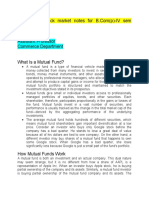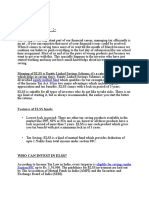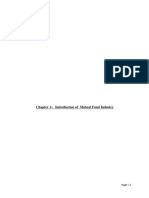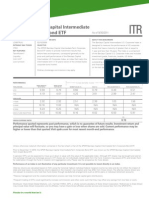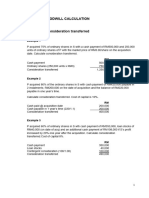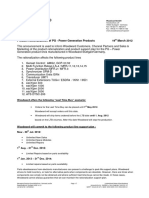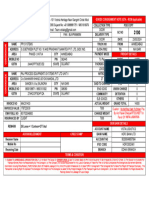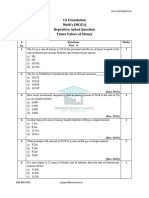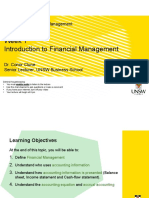MEANING OF MUTUAL FUNDS
➢ MEANING OF MUTUAL FUND:
Mutual funds are a type of pooled investment that allows several shareholders to
participate in bonds, stocks and other assets. It can be difficult for individual investors
to buy shares in high-profile portfolios. Various kinds of mutual funds are available in
the market depending on their risk-to-return ratio. Mutual funds enable investors to
diversify their investments rather than putting all their money in one single place.
A mutual fund manager selects where and when people can invest their money in this
fund. One can choose mutual funds as an ideal investment option as it provides entry to
professionally managed portfolios of bonds, equities, stocks and other financial
instruments. As a result, each stakeholder shares equal profits or losses. Mutual funds
invest in a broad array of assets and their success is often measured as the change in the
fund’s total market value, calculated by summing up the performance of the underlying
investment.
➢ TYPES OF MUTUAL FUNDS
The major categories and sub-categories of Mutual Funds
1. Types of Equity Mutual Funds
Equity mutual funds invest at least 65% of their assets in equity and equity-related
instruments. These funds aim for high returns by capitalizing on the growth potential of
these companies.
1
� Large Cap Mutual Funds
Large cap funds invest in large, listed companies, the top 100 companies according to
market capitalization. These companies are market leaders in their respective industries
like Reliance, TCS, Infosys, Bharti Airtel, HDFC etc. Large cap funds must invest a
minimum of 80% of their assets in equity and equity related instruments of large cap
companies. How much they want to invest in which large stock is decided by the fund's
strategy. Due to their major exposure to big companies, large cap funds are considered
less risky and more stable.
Mid Cap Mutual Funds
These Funds buy stocks of top companies between 101 to 250 according to market
capitalization. Mid cap companies have a market capitalization between Rs.5000 crore
to Rs.20000 crore. These companies have a higher potential to grow. Currently, some of
these companies are Hitachi Energy India, Bank of Maharashtra, Suzlon Energy, Blue
Star, etc. Mid cap funds are considered more riskier than large cap funds but have
chances to surpass the returns of the latter.
Small Cap Mutual Funds
Stocks of small companies are the major underlying assets of small cap funds. These
companies have a market capitalization of less than Rs.5000 crore. They have a high
growth potential but also a lot of risk is aligned with them. SEBI says all the companies
ranked from 251 onwards in terms of market capitalization are by default becoming
part of small cap companies. JK Laxmi cement, Lux Industries, Edelweiss, Birla Corp, etc.
Small cap funds must invest a minimum of 65% of their assets in equity and equity
related instruments of small cap companies. Small cap funds can deliver fantastic
returns but at the same time, the chances of volatility are very high.
Large and Mid-Cap Funds
These Funds are blend of large and Mid-cap stocks. Instead of investing their major
amount of money in one category of stocks, Large and Mid-cap funds distribute their
asset according to the following strategy: a minimum of 35% of assets invested in large
cap stocks and a minimum of 35% invested in mid cap stocks. These funds expect to
provide returns higher than large cap funds, but less risky than mid and small cap funds.
MultiCapfunds
There is no restriction on multi cap funds to follow an investment strategy which is
confined to specific market capitalization. These funds invest in any company’s stock
irrespective of market capitalization and diversify their portfolio. Any stock can be a
part of their investment portfolio, not matter If it belongs to a large cap company or
small cap company.
2
� 2. Debt Mutual Funds
Debt mutual funds invest in fixed income instruments like bonds, government securities,
and money market instruments. These funds aim to provide stable returns and preserve
capital. Interest rate changes impact their performance.
3. Hybrid Funds
Hybrid mutual funds combine investments in both equity and debt
instruments. This mix helps balance risk and reward. They are designed to
provide growth from equities and stability from debt. Examples include
aggressive hybrid funds (more equity) and conservative hybrid funds (more
debt).
4. Solution Oriented Funds
Solution-oriented mutual funds are designed to provide specific financial
goals like retirement planning and children's education. These funds have a
lock-in period of at least five years or until the goal is achieved. These funds
may invest in a mix of equity and debt based on the goal's time horizon
These funds are long term funds, also known as pension funds. People
invest for their retirement and funds provide a regular income to investors
after their retirement until the corpus is there or withdrawn by the
investor.
Other Mutual Funds
Index Funds
Index funds track a specific index like Nifty or Sensex. These funds are passively
managed, meaning the fund manager invests in the same securities as the underlying
index, in the same proportion, without changing the portfolio composition. An index can
include a mix of equity, equity-related instruments, and bonds. Index funds ensure they
invest in all the securities tracked by the index, aiming to either match or outperform
their benchmark.
3
� DSP ELSS Tax Saver Fund
The DSP ELSS Tax Saver Fund is an Equity Linked Savings Scheme (ELSS) mutual fund
that aims to provide long-term capital appreciation
The DSP ELSS Tax Saver Fund is an equity mutual fund that offers tax benefits under
Section 80C with a 3-year lock-in period. It aims for long-term capital growth by
investing in equity and related instruments. Suitable for tax-saving and wealth creation
with higher risk tolerance.
What it is ELSS fund?
An ELSS fund is a type of mutual fund that invests in equities and equity-related
instruments. ELSS funds are also known as tax-saving funds because they offer tax
deductions under Section 80C of the Income Tax Act.
How it works?
The fund invests in a variety of companies across market caps, with a minimum of 80%
of its assets in equity stocks. The fund manager selects stocks after an in-depth analysis.
Benefits
ELSS funds offer tax deductions of up to Rs 1.5 lakh per financial year. They also have a
relatively short lock-in period of three years compared to other tax-saving options.
Risk
ELSS funds are considered to have a very higher risk level. However, the risks may
average out over longer periods of time.
How to invest
You can buy DSP ELSS Tax Saver Fund directly from the DSP Mutual Fund website, or
through platforms like MF Central or MF Utility. You can also seek help from a mutual
fund distributor, such as your bank.
Investment objective
The DSP ELSS Tax Saver Fund aims to generate medium to long-term capital
appreciation by investing in companies across market caps.
Risk Involved : The DSP ELSS Tax Saver Fund is an equity mutual fund that carries a high
market risk:
• Fund value fluctuations: The value of the fund can fluctuate significantly during
periods of high volatility.
• Negative returns: Returns can become negative in the short term.
4
�• Stock price changes: The fund value can go up or down as the underlying stock
price changes.
• Economic developments: Stock prices can be affected by interest rates, exchange
rates, government policies, tax laws, and other economic developments.
Fund Managers of DSP ELSS Tax saver funds
1. Rohit Singhania (Jul 2015-Present)
➢ Education: Mr. Singhania is an MMS.
➢ Experience: Prior to joining DSP AMC. He has work with HDFC Securities Ltd. IL&FS
Investment LTD.
➢ Also manage the Schemes:
• DSP Aggressive Hybrid Fund Direct Growth
• DSP Natural Resources and New Energy Fund Plan
• DSP Flexi Cap Fund Direct Plan Growth
• DSP Equity Opportunities Direct Plan Growth
2. Charanjit Singh (May 2023-Present)
➢ Education: Mr. Singh is B. Tech Electronics and Communications, MBA
Finance and Systems.
5
� ➢ Experience: Prior to joining DSP Mutual Fund, he has worked with Capital
Goods, Power & Infra at B&K Securities India, Capital Goods and Infra at
Axis Capital Ltd,
➢ BNP Paribas India Securities, Thomas Weisel Partners, HSBC, IDC Corp.
and Frost & Sullivan.
➢ Also manages these schemes
• DSP Equity Opportunities Direct Plan Growth
• DSP ELSS Tax Saver Direct Plan Growth
• DSP India T.I.G.E.R.
• DSP Business Cycle Fund Direct Growth
DSP ELSS Tax Saver Fund-Growth Fund Key Highlights:
1. Current NAV: The Current Net Asset Value of the DSP ELSS Tax Saver Fund as of
Nov 29, 2024 is Rs 136.89 for Growth option of its Regular plan.
2. Launch Date: Jan 18, 2007
3. Return Since Launch: 15.76%
4. Risk meter: Very High
5. Fund Size: The DSP ELSS Tax Saver Fund currently holds Assets under
Management worth of Rs 16841.4927 crore as on Sep 30, 2024.
6. Expense ratio: The expense ratio of the fund is 1.64% for Regular plan as on Oct
31, 2024.
7. Exit Load: The given fund doesn't attract any Exit Load.
8. Minimum investment amount: ₹500 for lump sum and SIP
9. Annualized returns: 23.19% for the past 3 years and 19.05% for the past 5 years
Comparison Between PPF, NSC and ELSS
Instrument Expected Return Lock-In Period
National Savings 8.16% 6 years
Certificate (NSC)
Public Provident Fund 8.50% Up to 15 years
(PPF)
Mutual Fund ELSS Around 15%-20% 3 years
6
� SIP Returns
Period Investments Latest Value Absolute Annualised Returns
Invested for Returns
1 year 12000 13485.9 12.38 % 23.55 %
2 years 24000 32358.42 34.83 % 31.56 %
3 years 36000 53185.05 47.74 % 26.98 %
5 years 60000 112657.93 87.76 % 25.45 %
10 years 120000 324051.17 170.04 % 18.86 %
Stocks Holdings in Portfolio
Stock Sector % of Total 1M Change 1Y Highest 1Y Lowest
Invested in Holdings Holding Holding
HDFC Bank Private 9.53% 0.86% 9.53% 6.78%
Ltd sector Bank
ICICI Bank Private 7.53% 0.70% 8.43% 6.1%
sector bank
State Bank Public 4.07% 0.60% 4.88% 3.45%
of India sector bank
Axis Bank Private 3.45% 0.18% 3.73% 2.74%
Ltd sector bank
Kotak Private 2.63% 0.25% 2.63% 0.95%
Mahindra sector bank
Bank



























